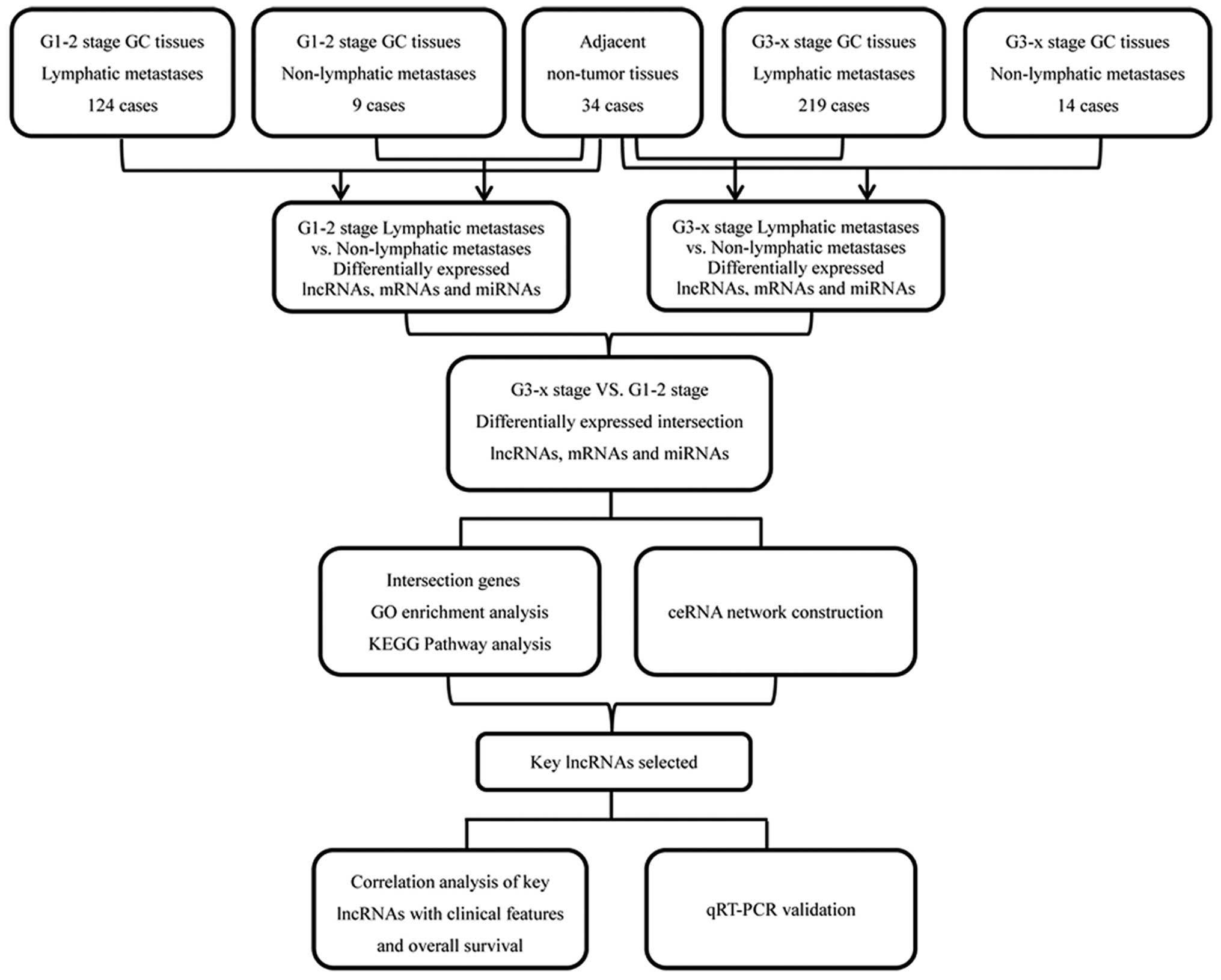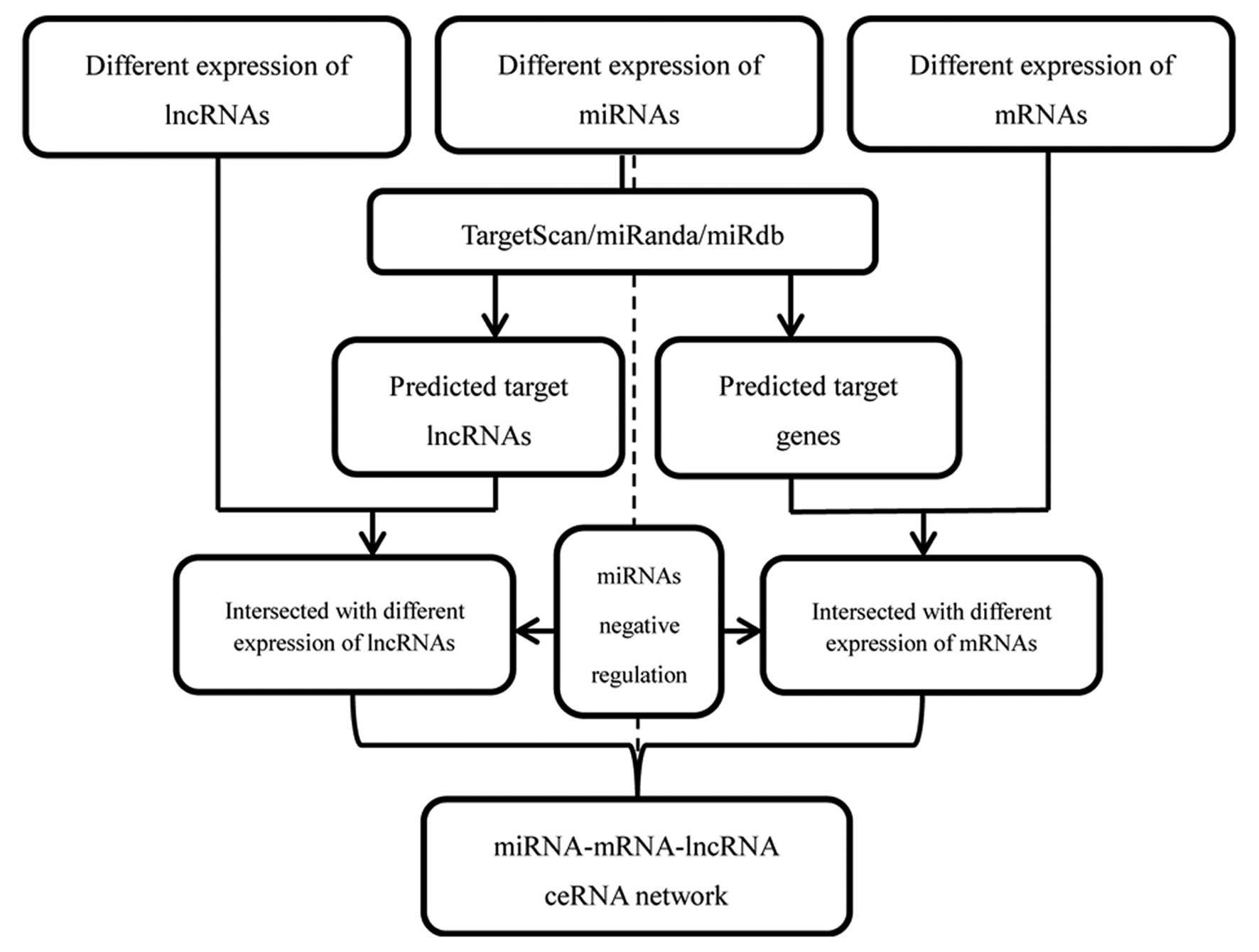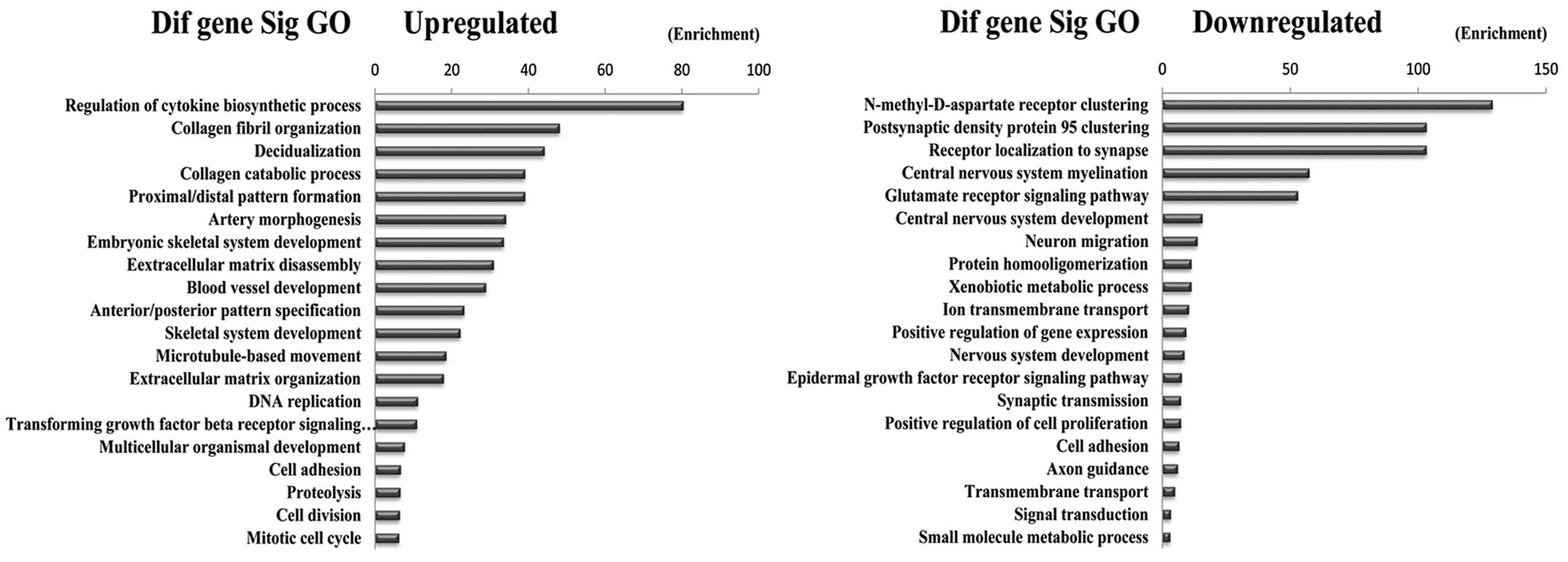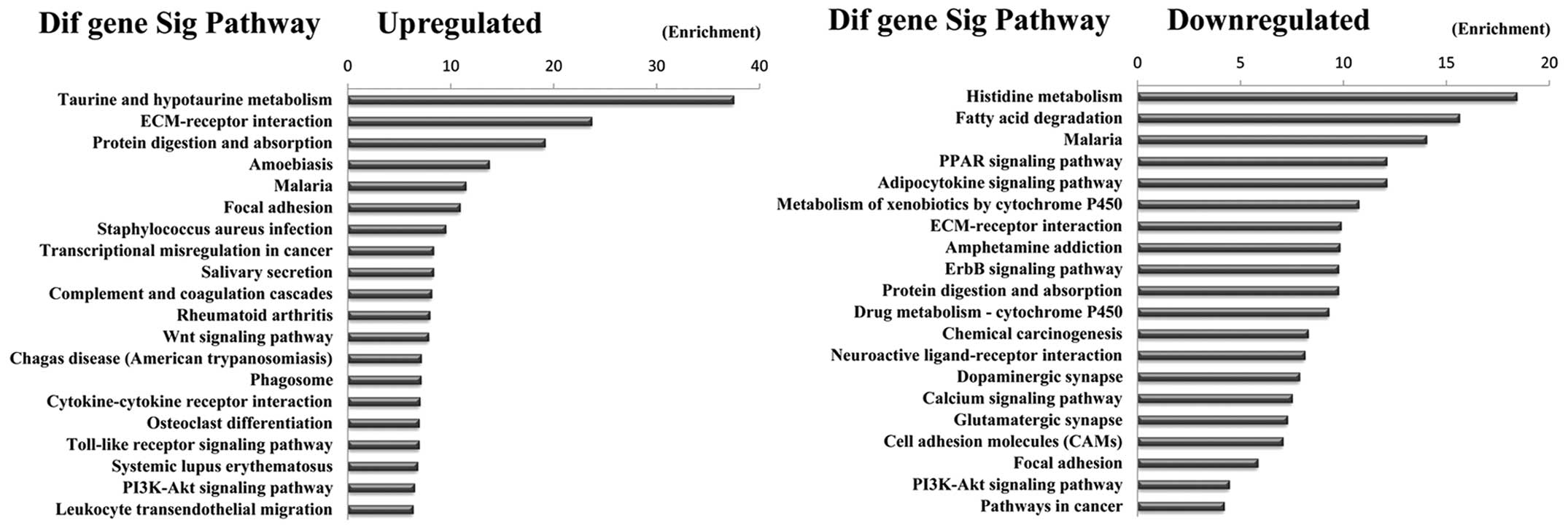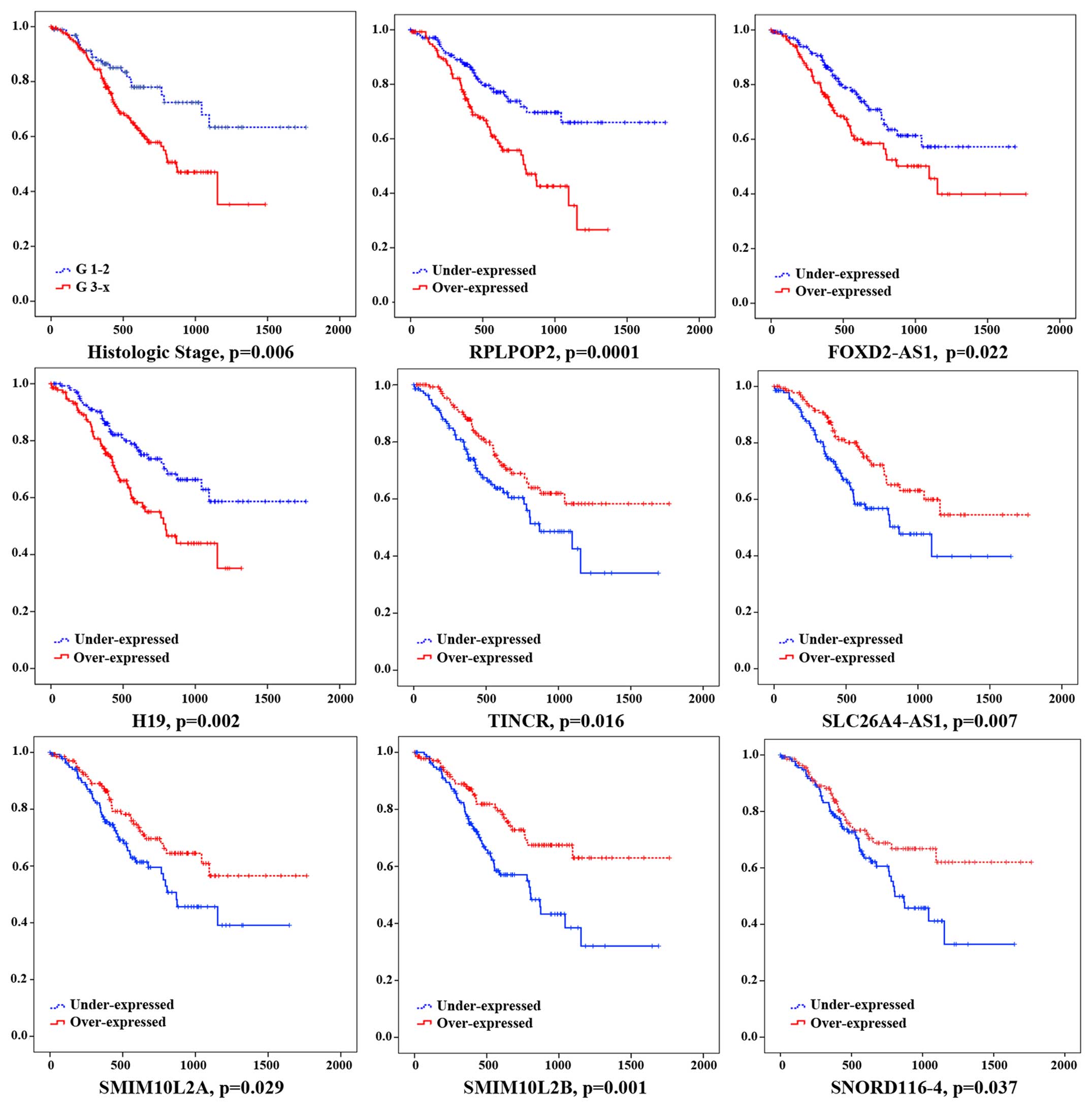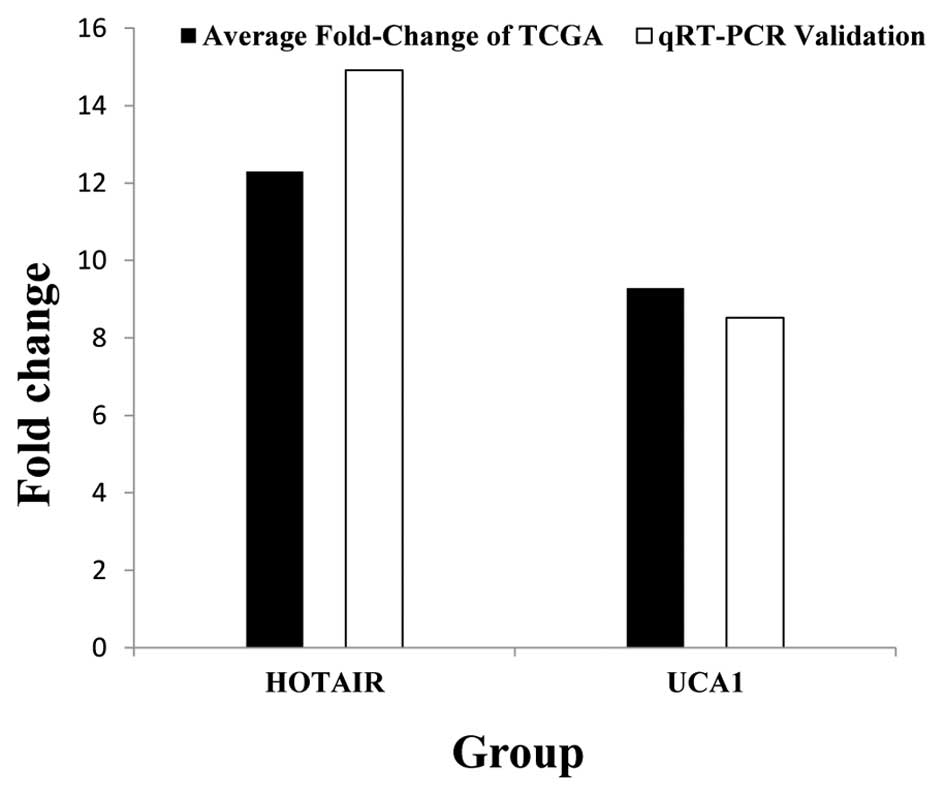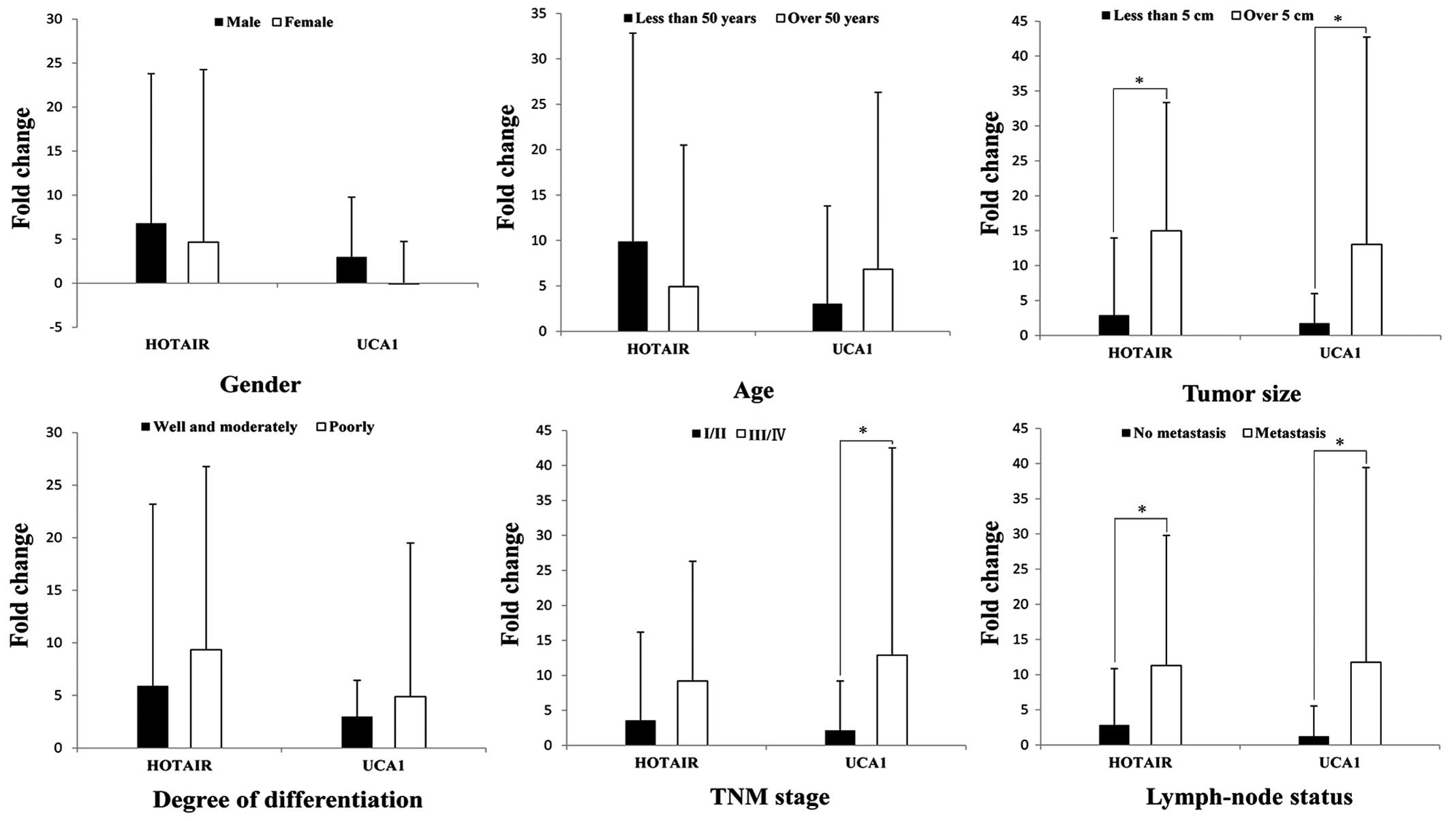Integrated analysis of long non-coding RNA competing interactions reveals the potential role in progression of human gastric cancer
- Authors:
- Published online on: February 24, 2016 https://doi.org/10.3892/ijo.2016.3407
- Pages: 1965-1976
Abstract
Introduction
Noncoding RNAs (ncRNAs) are transcripts that have no ability of coding proteins, which widely exit in high eukaryotics. According to their characteristics, ncRNAs can be divided into several subtypes including transfer RNA, small nucleolar RNA (snoRNA), ribosomal RNA (rRNA), microRNA (miRNA) and long non-coding RNA (lncRNA). The amount of the ncRNAs transcripts is >98% of the whole genome transcripts and have been suggested to represent transcriptional noise (1). However, more and more evidence indicates that transcriptional output of genome is far more complex than predicted, and suggests new paradigms of ncRNA regulation (2).
Recent studies suggest that the ncRNAs may play important biological roles in transcriptional regulation, cellular development, formation of chromosome and RNA modification (3). Based on the transcript size, ncRNAs are grouped into small ncRNAs (<200 bp) and long ncRNAs (>200 bp, up to 100 kb). lncRNA is the functional end-product, and the level of lncRNA expression correlates directly with the level of the active molecule. Thus, the use of lncRNAs in diagnostics has intrinsic advantages over the use of protein-coding RNAs (4). In addition, lncRNAs show greater tissue specificity compared to miRNAs and protein-coding mRNAs, making them attractive in the search for novel diagnostic and prognostic cancer biomarkers (5). Increasing number of evidence shows that lncRNAs regulate the biological roles of various cancers in progression and development, including gastric cancer (GC) (6), esophageal cancer (7), hepatocellular carcinoma (HCC) (8), colorectal cancer (9), and lung cancer (10). According to the theory lncRNAs can regulate miRNAs and mRNAs by sequestering and binding them, many researchers also found lncRNA regulation of progression in GC (11,12). In addition, cancer specific lncRNAs may also relate to invasion and metastasis of GC (13).
LncRNAs play important biological roles as a regulatory molecule through a variety of mechanisms. Salmena et al, presented the competing endogenous RNA (ceRNA) hypothesis, indicated that RNA transcripts communicate with each other by miRNA response elements (14). This competition between mRNAs, lncRNAs and pseudogene transcripts regulate each other's expression by using miRNA response elements (MREs) to compete for the binding of miRNAs, which exert an important role in the initiation and progression of tumor (15).
Gu et al (16), reported abnormal lncRNA expression profile of GC by microarray analysis from six GC patients. To date, there is also lack of large sample size studies and cancer specific lncRNA biomarkers or detection methods in GC. Moreover, small sample studies can not explain whether abnormal lncRNAs are related with gender, survival or other clinical features with statistical power. The Cancer Genome Atlas (TCGA) (http://cancergenome.nih.gov) project data portal provides a platform of RNA sequencing with mRNA, miRNA and lncRNA data for GC. To improve the reliability and accuracy of the results, we further explored lncRNAs in GC using data sets by the tools of TCGA. A total of 361 samples of GC tumor tissues, and 34 adjacent non-tumor stomach tissue RNA sequence results were included from TCGA. To the best of our knowledge, our study is the first to use the large scale sequencing database to explore the cancer specific lncRNA expression profiles and ceRNAs co-expression network in GC. We also used quantitative RT-PCR (qRT-PCR) validation for some of these bioinformatic analysis results in tumor tissues and adjacent non-tumor tissues from 82 newly diagnosed GC patients. This approach of finding cancer specific lncRNAs and ceRNA related network can help to clarify the functions of lncRNAs in GC.
Materials and methods
Patients and samples
A total of 443 patients with GC were collected from the TCGA database. The criteria of exclusion were set as follows: i) tissues samples without completed data for analysis; ii) histologic diagnosis is not stomach adenocarcinoma; iii) suffering of other malignancy except GC; iv) patients had received preoperative chemoradiation; and v) overall survival time more than 5 years. Overall, a total of 361 GC patients were included in our study. Among these 361 GC patients, the GC tumor tissues were obtained from 361 subjects and the adjacent non-tumor stomach tissues were from 34 subjects. In addition, there are 338 GC patients with lymphatic metastases and 23 GC patients with non-lymphatic metastases. According to the histologic staging data, well and moderately-differentiated adenocarcinoma GC (G1-2 stage) were 133 cases, and poorly-differentiated adenocarcinoma GC (G3-x stage) were 228 cases. This study was fully compliance with the publication guidelines provided by TCGA. The data were obtained by using TCGA database, so the approval of ethics committee was not required.
In addition, 82 GC patient specimens, aged 45–70 years, and their paired adjacent non-cancerous tissue specimens were obtained from the Wuwei Tumor Hospital of Gansu (Wuwei, China), for quantitative RT-PCR analysis. All of these patients were assigned a diagnosis of GC based on histopathology and clinical history. Clinical information that was recorded for each specimen included age, tumor grade, cancer stage, tissue dimensions, and date of resection. None of the patients had received preoperative chemoradiation. Adjacent noncancerous tissues were located ≥5 cm from the tumor edge. Tissue samples were immersed in RNAlater (Ambion, Austin, TX, USA) and stored at −80°C until use.
RNA sequence data sets and differential analysis
The stomach adenocarcinoma (STAD) RNA expression profile data (level 3) of the corresponding patients were obtained from TCGA data portal (up to Nov 1, 2015) (https://tcga-data.nci.nih.gov/tcga/dataAccessMatrix.htm?mode=ApplyFilter). TCGA database provide the normalized count data of RNA sequencing including lncRNA and mRNA expression profiles by RNASeqV2 system. The STAD level 3 microRNA sequencing (miRNAseq) data, downloaded from TCGA database, were collected by Illumina HiSeq 2000 microRNA sequencing platforms (Illumina Inc., Hayward, CA, USA). The downloaded data including many individual data files consist of one for each tissue sample. TCGA database have already normalized these RNA expression profile data, so no further normalization was required. In the next step, we compared the differentially expressed lncRNAs, mRNAs and miRNAs in 3 levels, including, GC patient tumor tissues/adjacent non-tumor stomach tissues, lymphatic metastases of GC patients/non-lymphatic metastases of GC patients, well and moderately-differentiated (G1-2 stage) adenocarcinoma of GC/poorly-differentiated (G3-x stage) adenocarcinoma of GC, respectively. Then, we chose intersection lncRNAs, mRNAs and miRNAs in the above 3 levels for further analysis. Fig. 1 depicts a flow chart for bioinformatics analysis.
GO and Pathway analysis
Differentially expressed intersection mRNAs were entered into the Gene Ontology database (http://www.geneontology.org), which utilized GO to identify the molecular function represented in the gene profile. Up and downregulated genes were analyzed, respectively. The Kyoto Encyclopedia of Genes and Genomes (KEGG) (http://www.kegg.jp/) was used to analyze the potential functions of these genes participated in the pathways (17).
Construction of the ceRNA network
According to the relationship among lncRNA, miRNA and mRNA, the posttranscriptional regulation of mRNA transcripts bound by single-stranded miRNAs is basically established. In this study, we built miRNA-lncRNA-mRNA ceRNA network which are based on the theory that lncRNA can regulate miRNA abundance by sequestering and binding them, acting as so-called miRNA sponges. We chose differentially expressed intersection miRNA, lncRNA, and mRNA with fold change >2.0 (including upregulation and downregulation) and p<0.05. Predicted differentially expressed miRNA targets in this study were determined using miRanda (http://www.microrna.org/microrna/home.do) to find the lncRNA-miRNA interactions, and using mRBase targets (http://mirdb.org/miRDB/) and Targetscan (http://www.targetscan.org/) to predict target genes. Next the study combined the information of miRNAs predicted and differentially expressed data of TCGA to choose the inter section lncRNAs and mRNAs. Then, according to the theory of ceRNA, we chose the miRNA negatively regulated intersection expression of lncRNAs and mRNAs to construct the ceRNA network. The ceRNA networks were constructed and visualized using Cytoscape v3.0 (18). Fig. 2 depicts a flow chart for ceRNA network construction.
Key lncRNAs and clinical feature analysis and qRT-PCR validation
According to the bioinformatics analysis and the ceRNA network, key lncRNAs were chosen. We further analyzed the clinical features including race, gender, tumor grade, TNM stage, pathological stage and invasion. In addition, our study also analyzed the association between the key lncRNAs and the GC patient survival time. Finally, we selected some of the key lncRNAs and used qRT-PCR to validate the results of bioinformatics analysis from 82 newly diagnosed GC patients.
Statistical analysis
All the results were expressed as mean ± SD. Statistical analysis was done with Student's t-test for comparison of two groups in data analysis, and ANOVA for multiple comparisons. In both cases, differences with p<0.05 were considered statistically significant. The statistical significance of data analysis results was analyzed by fold change and Student's t-test. False discovery rate was calculated to correct the p-value. qRT-PCR relative fold change results are calculated using the 2−ΔΔCt method (19), where [ΔCt = (Ct RNAs - Ct GAPDH) and ΔΔCt = ΔCt tumor tissues - ΔCt adjacent non-tumor tissues].
Results
Cancer specific lncRNAs in GC
We identified that 268 lncRNAs were differentially expressed between GC tumor tissues and adjacent non-tumor tissues from TCGA database (absolute fold change >2, p<0.05). In further analysis of these differentially expressed lncRNAs, between GC tumor tissues and adjacent non-tumor tissues, we found 208 lncRNAs were differentially expressed between G1-2 stage (lymphatic metastasis) GC tumor tissues and adjacent non-tumor tissues; 48 lncRNAs were differentially expressed between G1-2 stage (non-lymphatic metastasis) GC tumor tissues and adjacent non-tumor tissues; 153 lncRNAs were differentially expressed between G3-x stage (lymphatic metastasis) GC tumor tissues and adjacent non-tumor tissues; 101 lncRNAs were differentially expressed between G3-x stage (non-lymphatic metastasis) GC tumor tissues and adjacent non-tumor tissues. To further enhance the reliability of the bioinformatics analysis, we selected 25 lncRNAs included in the intersection of the above analyzed levels (Fig. 3A). Finally, 25 lncRNAs (16 upregulated; 9 down regulated) were selected to build the ceRNA network (Table I).
Table IDifferentially expressed intersection lncRNAs between G1-2 LM/Normal, G1-2 nLM/Normal, G3-x LM/Normal and G3-x nLM/Normal.a |
GO and Pathway analysis of differentially expressed genes
Predicted functions of differentially expressed genes in this study were determined by intersection mRNAs. Our study found that 3719 mRNAs were differentially expressed between GC tumor tissues and adjacent non-tumor tissues in TCGA. We further analyzed these differentially expressed genes and found 2605 mRNAs were differentially expressed between G1-2 stage (lymphatic metastasis) GC tumor tissues and adjacent non-tumor tissues; 841 mRNAs were differentially expressed between G1-2 stage (non-lymphatic metastasis) GC tumor tissues and adjacent non-tumor tissues; 2318 mRNAs were differentially expressed between G3-x stage (lymphatic metastasis) GC tumor tissues and adjacent non-tumor tissues; 1633 mRNAs were differentially expressed between G3-x stage (non-lymphatic metastasis) GC tumor tissues and adjacent non-tumor tissues. Finally, we selected 489 mRNAs, which included in the intersection of the above analyzed levels (Fig. 3B).
The 489 differentially expressed genes were further analyzed by Gene Ontology database (http://www.geneontology.org). The upregulated and down regulated genes were analyzed, respectively. We analyzed the enrichment of these differentially expressed genes. Enrichment provides a measure of the significance of the function, and as the enrichment increases, the corresponding function is more specific, which helps us to identify GO with a more definitive functional description (20). The results showed that the highest enriched GOs targeted by upregulated transcripts were ‘Regulation of cytokine biosynthetic processes’. The highest enriched GOs targeted by downregulated transcripts were ‘N-methyl-D-aspartate receptor clustering’ (Fig. 4).
Pathway analysis indicated that 23 pathways corresponded to upregulated transcripts and that the most enriched network was ‘Taurine and hypotaurine metabolism’. Moreover, pathway analysis also showed that 39 pathways corresponded to downregulated transcripts and that the most enriched network was ‘Histidine metabolism’. Among these pathways, such as the ‘PI3K-Akt signaling pathway’, is involved in the carcinogenesis of gastric adenocarcinoma metastases (21), the ‘Wnt signaling pathway’ has been investigated as a cause of adenocarcinoma invasion (22) and the gene category ‘Pathways in cancer’ is involved in the development of GC. In addition, some pathways such as ‘Small cell lung cancer, Cell adhesion molecules (CAMs), Proteoglycans in cancer and Transcriptional regulation in cancer’ were also reported as cancers related pathways (23,24) (Fig. 5).
Predicted miRNAs targeted relationship and ceRNA network construction
In this study we have found 105 GC associated miRNAs which were differentially expressed between GC tumor tissues and adjacent non-tumor tissues. We selected 22 intersection miRNAs from 105 GC associated miRNAs by bioinformatics analysis from G1-2 lymphatic metastases GC patients /non-lymphatic metastases GC patients and G3-x lymphatic metastases GC patients /non-lymphatic metastases GC patients (Fig. 3C). In the next step, we focused on whether these intersection miRNAs would target the above 25 GC specific lncRNAs. In the ceRNAs network, 17 miRNAs targeted 19 key lncRNAs were predicted though miRcode (http://www.mircode.org/) (25) (Table II).
Then, in order to establish the lncRNA-miRNA-mRNA ceRNAs network, we also search for mRNAs targeted by miRNAs. According to the miRNAs described in Table II, we predicted miRNAs targeted mRNAs though miRTarBase (http://mirtarbase.mbc.nctu.edu.tw/) (26). Finally, we selected the intersection mRNAs through the predicted mRNAs and bioinformatics analyzed differentially expressed 489 mRNAs. The results identified 14 miRNAs (Table III) related to the 67 intersection mRNAs, and some of them have been reported to be cancer-associated genes such as COL1A1, FIGF, GHR, HOXC10, HOXC13, HOXC8, LIFR and SF11B.
Based on Tables II and III, we constructed a miRNA-lncRNA-mRNA ceRNA network. The miRNA-lncRNA-mRNA relationship was integrated into the ceRNA network through negative regulation. The ceRNA network was drawn using Cytoscape 3.0. Nineteen lncRNAs, 22 miRNAs (Tables II and III complementary miRNAs) and 67 mRNAs were involved in the ceRNA network (Fig. 6). We also analyzed the mRNAs involved in ceRNA network to understand the lncRNAs indirectly regulated signal pathways by DAVID database (https://david.ncifcrf.gov/). According to the number of mRNAs involved, we listed the top 8 KEGG pathways in our study (Table IV). Four cancer-related pathways including pathways in ‘Pathways in cancer, Small cell lung cancer, Renal cell carcinoma and PI3K-Akt signaling pathway’ were enriched with the mRNAs, another 4 non-cancer related pathways such as ‘Focal adhesion, ECM-receptor interaction, Histidine metabolism and ErbB signaling pathway’ were also enriched.
Key lncRNAs and clinical feature association and qRT-PCR validation
The 19 key lncRNAs from the ceRNA network were further analyzed according to the clinical features, respectively, including race, gender, tumor grade, TNM stage and lymphatic metastasis status in TCGA data sets. There were 14 GC specific lncRNAs, the expression levels of which were significantly different in comparison of clinical features (p<0.05). We found that ATP8B5P, FOXD2-AS1, UCA1, GUCY1B2, RHPN1-AS, TSPEAR-AS2, LOC100128164 and SLC26A4-AS1 were linked to tumor grade, PVT1, H19 and PART1 were linked to TNM stage, LOC553137, HOTAIR and TINCR were linked to lymphatic metastasis (Table V).
Furthermore, to further identify the 19 key lncRNAs with prognostic characteristics from 361 GC patients, the lncRNA data set and the overall survival information were profiled by the univariate Cox proportional hazards regression model and 8 lncRNAs were found significantly associated with GC patients' overall survival (log-rank p<0.05). Among the 8 significant lncRNAs, 3 lncRNA (RPLP0P2, FOXD2-AS1 and H19) were negatively associated with overall survival (p<0.05), while the remaining 5 lncRNA (TINCR, SLC26A4-AS1, SMIM10L2A, SMIM10L2B and SNORD116-4) were positively correlated with overall survival (p<0.05) (Fig. 7).
Subsequently, to confirm the reliability and validity of the above analyzed results, we random selected 2 key lncRNAs (HOTAIR, UCA1) and analyzed their actual expression levels in 82 newly diagnosed tumor tissues of GC patients and adjacent non-tumor tissues. Results suggest that HOTAIR and UCA1 both were significantly higher expressed in GC tumor tissues than adjacent non-tumor tissues. The results from the qRT-PCR validation in 82 newly diagnosed GC patients and the above bioinformatics results (Table I) were 100% in agreement (Fig. 8). To further analyze the association between the 2 key lncRNAs and clinicopathological characteristics of 82 GC patients, we found that HOTAIR was significantly associated with tumor size and lymphatic metastasis, and UCA1 was significantly associated with tumor size, TNM stage and lymphatic metastasis (Fig. 9). The two lncRNAs are clinically relevant and the results of bioinformatics analysis were almost the same, and the results showed that our bioinformatics analysis is credible.
Discussion
Although over several decades there appears to a slight decline in gastric cancer (GC) incidence and associated mortality (27), it still has outstanding incidence and mortality in China, with a large number of patients diagnosed with an advanced stage and poor prognosis (28). Many Japanese series have consistently reported that early diagnosis and treatment of GC, with a 5-year survival rate approximately 90% (29). However, the diagnosis of gastrointestinal (GI) endoscopy cannot find all precancerous diseases and the early stages GC (30). Therefore, in order to improve this situation, increasing attention has been given to the identification of genes and the exact regulatory mechanism of GC development and progress. Recent years, lncRNAs have been found to be associated with wide range of biological regulatory functions (31). Many studies have reported that lncRNAs participated in pathogenesis of cancers, epigenome, levels of transcription and post-transcription (32–34). To date, only a few studies have reported the expression profiles of lncRNA in GC by microarray or sequencing, and with small sample size (35). LncRNA and mRNA co-expression network was built by significantly differently expressed lncRNA and mRNA (36). In addition, some studies also described interactions between lncRNAs and miRNAs (37–39) or lncRNAs and mRNAs (40) in GC, the results of which showed that lncRNAs may function as a part of GC related regulation network, but lncRNA functions are still poorly explored.
In the present study, we identified tumor grade and lymphatic metastasis related specific lncRNAs, mRNAs and miRNAs in GC from TCGA database. We predicted functions of differentially expressed genes in GC by GO and Pathway analysis. Then, according to the bioinformatics differential analysis we constructed a ceRNA network with tumor grade and lymphatic metastasis related GC specific lncRNAs, mRNAs and miRNAs, which provides an integrated biological views of ceRNA network. Furthermore, we selected key lncRNAs from ceRNA network and further investigated their distributions in different GC clinical features and their correlations with overall survival on the basis of RNA sequencing profile from TCGA. Finally, we randomly selected two key lncRNAs (HOTAIR, UCA1) and analyzed their actual expression levels in the 82 newly diagnosed tumor tissues of GC patients and adjacent non-tumor tissues using qRT-PCR and further analyzed the association between the two key lncRNAs and clinicopathological characteristics to confirm the reliability and validity of the results of the bioinformatics analysis.
Based on the RNA sequence data from TCGA, we found that 25 specific lncRNAs, 22 specific miRNAs and 489 specific lncRNAs were differentially expressed in different tumor stage and lymphatic metastasis of GC patients from 361 GC tumor tissues and 34 non-tumor stomach tissues. Focusing on dysregulation mRNAs through GO and Pathway analysis, the GO results suggested the functions of significant differences in the aspects of immune functions, metabolism and cellular functions, the significant differences in the pathways mainly focus on cancer-related pathways such as ‘PI3K-Akt signaling pathway, Wnt signaling pathway, pathways in cancer and small cell lung cancer’. Many pathway-related analysis of the GC significant difference genes, Liu et al (41) and Ren et al (42), also found ‘PI3K-Akt signaling pathway and Wnt signaling pathway’ were related with GC cell functions.
In addition, many studies have reported that lncRNAs may function as ceRNA regulators to communicate with other RNA transcripts (15,43–45). For example, the lncRNA H19 has been shown to play an important role in tumor progress (46), by acting as an endogenous RNA sponge to inhibit miR-675 in breast cancer and reducing miR-675 mediated translational repression of c-Cb1 and Cb1-b (47). Therefore, there may be some internal contact between lncRNA-miRNA-mRNA in the progress and development of GC. Based on significant differences in lncRNA, miRNA and mRNA expression data, we construction the ceRNA network by bioinformatics prediction and correlation analysis. The ceRNA network we built reveals an unknown ceRNA regulatory network in GC. Recent study also identified that lncRNA interactions with miRNA and mRNA might act as potential diagnosis and prognosis biomarkers in cancer, such as H19, PVT1, HOTAIR, UCA1 and TINCR (7,48–51). In our ceRNA network, we also found these key lncRNAs. Furthermore, many genes from the ceRNA network also were reported as oncogenes and tumor suppressors participating in cancer development and progression, such as COL1A1, FIGF, GHR, HOXC10, LIFR and SF11B (52–54). In the present study, we analyzed the GC specific lncRNA indirectly related mRNAs signal pathways involved in ceRNA network. The pathways analysis results showed that there were four pathways related with cancer. In addition, Ke et al also found that the miR-326 was overexpressed after knockdown lncRNA HOTAIR in glioma cells, which reduced FGF1 expression by activating the PI3K/AKT pathway (55). Therefore, our results suggested that these key lncRNAs may play an important role in the progression and development of GC and the cancer genes related pathways.
To gain insight into the function of lncRNA, 19 key lncRNAs from ceRNA network were analyzed for associations with the clinical features such as gender, race, tumor grade, TNM staging and lymphatic metastasis. The results suggested that 14 lncRNAs were associated with the above indicators, such as HOTAIR, TINCR and H19. These indicators of lncRNAs mainly focus on tumor grade, TNM staging and lymphatic metastasis, among these lncRNAs, H19, and HOTAIR also were reported to be indicators of invasion and lymphatic metastasis of GC (56,57). However, the function of other lncRNAs has not been reported with relevant features yet. Then, we also analyzed the associations between the above 19 key lncRNAs and patient survival. The results showed that eight lncRNAs were related to GC overall survival. Among these eight lncRNAs only H19 has been reported in the survival of hepatocellular carcinoma (58), and the other lncRNAs (RPLP0P2, FOXD2-AS1, TINCR, SLC26A4-AS1, SMIM10L2A, SMIM10L2B and SNORD116-4) were not reported yet. However, the results of lncRNAs and overall survival reveals potential indictors of prognosis in GC.
Subsequently, we randomly selected two key lncRNAs (HOTAIR, and UCA1) and used qRT-PCR validation to confirm the reliability and validity of the above bioinformatics results from the 82 newly diagnosed GC patients. The results from the TCGA and qRT-qPCR experiments were 100% in agreement. Correlation analysis between the HOTAIR, UCA1 and the clinical features were performed. The results showed that HOTAIR was significantly correlated with tumor size and lymphatic metastasis, and UCA1 was significantly correlated with tumor size, TNM stage and lymphatic metastasis. The two lncRNAs are clinically relevant and the bioinformatics analysis were almost the same, and the results showed that our bioinformatics analysis is credible.
In conclusion, the present study successfully identified cancer specific lncRNAs in GC by bioinformatics analysis from hundreds of candidate lncRNAs and large scale samples in TCGA database. Moreover, we constructed a ceRNA network; it provided a new approach to lncRNA research in GC. Importantly, we analyzed abnormal expression pattern of GC specific lncRNAs under different clinical features and overall survival. We also used qRT-PCR validation for the reliability and validity of our bioinformatics analysis results. Results revealed that lncRNAs (ATP8B5P, FOXD2-AS1, GUCY1B2, H19, HOTAIR, LOC100128164, SNORD116-4, LOC553137, PART1, PGM5-AS1, PVT1, RHPN1-AS1, RPLP0P2, SLC26A4-AS1, SMIM10L2A, SMIM10L2B, TINCR, TSPEAR-AS2 and UCA1) may be considered as potential specificity biomarkers in the diagnosis, prognosis and classification of GC.
Acknowledgements
This study was financially supported by the National Natural Science Foundation of China (81472939, 81172618, 81502783), the Qing Lan Project (no. 2012), the 333 project of Jiangsu Province (no. 2012), the Liu Da Ren Cai Gao Feng Project of Jiangsu Province (no. 2013-WSW-053) and the Fundamental Research Funds for the Central Universities (no. 2014).
References
|
Guttman M, Amit I, Garber M, French C, Lin MF, Feldser D, Huarte M, Zuk O, Carey BW, Cassady JP, et al: Chromatin signature reveals over a thousand highly conserved large non-coding RNAs in mammals. Nature. 458:223–227. 2009. View Article : Google Scholar : PubMed/NCBI | |
|
Kapranov P, St Laurent G, Raz T, Ozsolak F, Reynolds CP, Sorensen PH, Reaman G, Milos P, Arceci RJ, Thompson JF, et al: The majority of total nuclear-encoded non-ribosomal RNA in a human cell is ‘dark matter’ un-annotated RNA. BMC Biol. 8:1492010. View Article : Google Scholar | |
|
Sana J, Faltejskova P, Svoboda M and Slaby O: Novel classes of non-coding RNAs and cancer. J Transl Med. 10:1032012. View Article : Google Scholar : PubMed/NCBI | |
|
Kunej T, Obsteter J, Pogacar Z, Horvat S and Calin GA: The decalog of long non-coding RNA involvement in cancer diagnosis and monitoring. Crit Rev Clin Lab Sci. 51:344–357. 2014. View Article : Google Scholar : PubMed/NCBI | |
|
Hung T and Chang HY: Long noncoding RNA in genome regulation: Prospects and mechanisms. RNA Biol. 7:582–585. 2010. View Article : Google Scholar : PubMed/NCBI | |
|
Pan W, Liu L, Wei J, Ge Y, Zhang J, Chen H, Zhou L, Yuan Q, Zhou C and Yang M: A functional lncRNA HOTAIR genetic variant contributes to gastric cancer susceptibility. Mol Carcinog. 55:90–96. 2016. View Article : Google Scholar | |
|
Huang C, Cao L, Qiu L, Dai X, Ma L, Zhou Y, Li H, Gao M, Li W, Zhang Q, et al: Upregulation of H19 promotes invasion and induces epithelial-to-mesenchymal transition in esophageal cancer. Oncol Lett. 10:291–296. 2015.PubMed/NCBI | |
|
Wang F, Xie C, Zhao W, Deng Z, Yang H and Fang Q: Long noncoding RNA CARLo-5 expression is associated with disease progression and predicts outcome in hepatocellular carcinoma patients. Clin Exp Med. Oct 3–2015.Epub ahead of print. View Article : Google Scholar | |
|
Zheng HT, Shi DB, Wang YW, Li XX, Xu Y, Tripathi P, Gu WL, Cai GX and Cai SJ: High expression of lncRNA MALAT1 suggests a biomarker of poor prognosis in colorectal cancer. Int J Clin Exp Pathol. 7:3174–3181. 2014.PubMed/NCBI | |
|
Loewen G, Jayawickramarajah J, Zhuo Y and Shan B: Functions of lncRNA HOTAIR in lung cancer. J Hematol Oncol. 7:902014. View Article : Google Scholar : PubMed/NCBI | |
|
Liu Y, Zhao J, Zhang W, Gan J, Hu C, Huang G and Zhang Y: lncRNA GAS5 enhances G1 cell cycle arrest via binding to YBX1 to regulate p21 expression in stomach cancer. Sci Rep. 5:101592015. View Article : Google Scholar : PubMed/NCBI | |
|
Li L, Zhang L, Zhang Y and Zhou F: Increased expression of LncRNA BANCR is associated with clinical progression and poor prognosis in gastric cancer. Biomed Pharmacother. 72:109–112. 2015. View Article : Google Scholar : PubMed/NCBI | |
|
Wang Y, Liu X, Zhang H, Sun L, Zhou Y, Jin H, Zhang H, Zhang H, Liu J, Guo H, et al: Hypoxia-inducible lncRNAAK058003 promotes gastric cancer metastasis by targeting γ-synuclein. Neoplasia. 16:1094–1106. 2014. View Article : Google Scholar : PubMed/NCBI | |
|
Salmena L, Poliseno L, Tay Y, Kats L and Pandolfi PP: A ceRNA hypothesis: The Rosetta Stone of a hidden RNA language? Cell. 146:353–358. 2011. View Article : Google Scholar : PubMed/NCBI | |
|
Song X, Cao G, Jing L, Lin S, Wang X, Zhang J, Wang M, Liu W and Lv C: Analysing the relationship between lncRNA and protein-coding gene and the role of lncRNA as ceRNA in pulmonary fibrosis. J Cell Mol Med. 18:991–1003. 2014. View Article : Google Scholar : PubMed/NCBI | |
|
Gu W, Gao T, Sun Y, Zheng X, Wang J, Ma J, Hu X, Li J and Hu M: LncRNA expression profile reveals the potential role of lncRNAs in gastric carcinogenesis. Cancer Biomark. 15:249–258. 2015. View Article : Google Scholar : PubMed/NCBI | |
|
Zhang T, Jiang M, Chen L, Niu B and Cai Y: Prediction of gene phenotypes based on GO and KEGG pathway enrichment scores. Biomed Res Int. 2013:8707952013.PubMed/NCBI | |
|
Shannon P, Markiel A, Ozier O, Baliga NS, Wang JT, Ramage D, Amin N, Schwikowski B and Ideker T: Cytoscape: A software environment for integrated models of biomolecular interaction networks. Genome Res. 13:2498–2504. 2003. View Article : Google Scholar : PubMed/NCBI | |
|
Vu HL, Troubetzkoy S, Nguyen HH, Russell MW and Mestecky J: A method for quantification of absolute amounts of nucleic acids by (RT)-PCR and a new mathematical model for data analysis. Nucleic Acids Res. 28:E182000. View Article : Google Scholar : PubMed/NCBI | |
|
Li X, Chen H, Li J and Zhang Z: Gene function prediction with gene interaction networks: A context graph kernel approach. IEEE Trans Inf Technol Biomed. 14:119–128. 2010. View Article : Google Scholar | |
|
Hao NB, Tang B, Wang GZ, Xie R, Hu CJ, Wang SM, Wu YY, Liu E, Xie X and Yang SM: Hepatocyte growth factor (HGF) upregulates heparanase expression via the PI3K/Akt/NF-κB signaling pathway for gastric cancer metastasis. Cancer Lett. 361:57–66. 2015. View Article : Google Scholar : PubMed/NCBI | |
|
Pan KF, Liu WG, Zhang L, You WC and Lu YY: Mutations in components of the Wnt signaling pathway in gastric cancer. World J Gastroenterol. 14:1570–1574. 2008. View Article : Google Scholar : PubMed/NCBI | |
|
Chatzinikolaou G, Nikitovic D, Stathopoulos EN, Velegrakis GA, Karamanos NK and Tzanakakis GN: Protein tyrosine kinase and estrogen receptor-dependent pathways regulate the synthesis and distribution of glycosaminoglycans/proteoglycans produced by two human colon cancer cell lines. Anticancer Res. 27:4101–4106. 2007. | |
|
Di J, Huang H, Qu D, Tang J, Cao W, Lu Z, Cheng Q, Yang J, Bai J, Zhang Y, et al: Rap2B promotes proliferation, migration, and invasion of human breast cancer through calcium-related ERK1/2 signaling pathway. Sci Rep. 5:123632015. View Article : Google Scholar : PubMed/NCBI | |
|
Jeggari A, Marks DS and Larsson E: miRcode: A map of putative microRNA target sites in the long non-coding transcriptome. Bioinformatics. 28:2062–2063. 2012. View Article : Google Scholar : PubMed/NCBI | |
|
Hsu SD, Tseng YT, Shrestha S, Lin YL, Khaleel A, Chou CH, Chu CF, Huang HY, Lin CM, Ho SY, et al: miRTarBase update 2014: An information resource for experimentally validated miRNA-target interactions. Nucleic Acids Res. 42:D78–D85. 2014. View Article : Google Scholar : | |
|
Patru CL, Surlin V, Georgescu I and Patru E: Current issues in gastric cancer epidemiology. Rev Med Chir Soc Med Nat Iasi. 117:199–204. 2013. | |
|
Li G, Hu Y and Liu H: Current status of randomized controlled trials for laparoscopic gastric surgery for gastric cancer in China. Asian J Endosc Surg. 8:263–267. 2015. View Article : Google Scholar : PubMed/NCBI | |
|
Tanaka N, Katai H, Taniguchi H, Saka M, Morita S, Fukagawa T and Gotoda T: Trends in characteristics of surgically treated early gastric cancer patients after the introduction of gastric cancer treatment guidelines in Japan. Gastric Cancer. 13:74–77. 2010. View Article : Google Scholar : PubMed/NCBI | |
|
Rajan E, Gostout CJ, Aimore Bonin E, Moran EA, Locke RG, Szarka LA, Talley NJ, Deters JL, Miller CA, Knipschield MA, et al: Endoscopic full-thickness biopsy of the gastric wall with defect closure by using an endoscopic suturing device: Survival porcine study. Gastrointest Endosc. 76:1014–1019. 2012. View Article : Google Scholar : PubMed/NCBI | |
|
Moran VA, Perera RJ and Khalil AM: Emerging functional and mechanistic paradigms of mammalian long non-coding RNAs. Nucleic Acids Res. 40:6391–6400. 2012. View Article : Google Scholar : PubMed/NCBI | |
|
Gutschner T and Diederichs S: The hallmarks of cancer: A long non-coding RNA point of view. RNA Biol. 9:703–719. 2012. View Article : Google Scholar : PubMed/NCBI | |
|
Zhang H, Chen Z, Wang X, Huang Z, He Z and Chen Y: Long non-coding RNA: A new player in cancer. J Hematol Oncol. 6:372013. View Article : Google Scholar : PubMed/NCBI | |
|
Kornienko AE, Guenzl PM, Barlow DP and Pauler FM: Gene regulation by the act of long non-coding RNA transcription. BMC Biol. 11:592013. View Article : Google Scholar : PubMed/NCBI | |
|
Song H, Sun W, Ye G, Ding X, Liu Z, Zhang S, Xia T, Xiao B, Xi Y and Guo J: Long non-coding RNA expression profile in human gastric cancer and its clinical significances. J Transl Med. 11:2252013. View Article : Google Scholar : PubMed/NCBI | |
|
Lin XC, Zhu Y, Chen WB, Lin LW, Chen DH, Huang JR, Pan K, Lin Y, Wu BT, Dai Y, et al: Integrated analysis of long non-coding RNAs and mRNA expression profiles reveals the potential role of lncRNAs in gastric cancer pathogenesis. Int J Oncol. 45:619–628. 2014.PubMed/NCBI | |
|
Zhou X, Ye F, Yin C, Zhuang Y, Yue G and Zhang G: The interaction between miR-141 and lncRNA-H19 in regulating cell proliferation and migration in gastric cancer. Cell Physiol Biochem. 36:1440–1452. 2015. View Article : Google Scholar : PubMed/NCBI | |
|
Chen X: Predicting lncRNA-disease associations and constructing lncRNA functional similarity network based on the information of miRNA. Sci Rep. 5:131862015. View Article : Google Scholar : PubMed/NCBI | |
|
Peng W, Si S, Zhang Q, Li C, Zhao F, Wang F, Yu J and Ma R: Long non-coding RNA MEG3 functions as a competing endogenous RNA to regulate gastric cancer progression. J Exp Clin Cancer Res. 34:792015. View Article : Google Scholar : PubMed/NCBI | |
|
Kong R, Zhang EB, Yin DD, You LH, Xu TP, Chen WM, Xia R, Wan L, Sun M, Wang ZX, et al: Long noncoding RNA PVT1 indicates a poor prognosis of gastric cancer and promotes cell proliferation through epigenetically regulating p15 and p16. Mol Cancer. 14:822015. View Article : Google Scholar : PubMed/NCBI | |
|
Liu M, Li CM, Chen ZF, Ji R, Guo QH, Li Q, Zhang HL and Zhou YN: Celecoxib regulates apoptosis and autophagy via the PI3K/Akt signaling pathway in SGC-7901 gastric cancer cells. Int J Mol Med. 33:1451–1458. 2014.PubMed/NCBI | |
|
Ren X, Zheng D, Guo F, Liu J, Zhang B, Li H and Tian W: PPARγ suppressed Wnt/β-catenin signaling pathway and its downstream effector SOX9 expression in gastric cancer cells. Med Oncol. 32:912015. View Article : Google Scholar | |
|
Wu Q, Guo L, Jiang F, Li L, Li Z and Chen F: Analysis of the miRNA-mRNA-lncRNA networks in ER+ and ER− breast cancer cell lines. J Cell Mol Med. 19:2874–2887. 2015. View Article : Google Scholar : PubMed/NCBI | |
|
Hu Y, Tian H, Xu J and Fang JY: Roles of competing endogenous RNAs in gastric cancer. Brief Funct Genomics. pii: elv036. Sep 24–2015.Epub ahead of print. View Article : Google Scholar : PubMed/NCBI | |
|
Zhang J, Fan D, Jian Z, Chen GG and Lai PB: Cancer specific long noncoding RNAs show differential expression patterns and competing endogenous RNA potential in hepatocellular carcinoma. PLoS One. 10:e01410422015. View Article : Google Scholar : PubMed/NCBI | |
|
Raveh E, Matouk IJ, Gilon M and Hochberg A: The H19 Long non-coding RNA in cancer initiation, progression and metastasis - a proposed unifying theory. Mol Cancer. 14:1842015. View Article : Google Scholar : PubMed/NCBI | |
|
Vennin C, Spruyt N, Dahmani F, Julien S, Bertucci F, Finetti P, Chassat T, Bourette RP, Le Bourhis X and Adriaenssens E: H19 non coding RNA-derived miR-675 enhances tumorigenesis and metastasis of breast cancer cells by downregulating c-Cbl and Cbl-b. Oncotarget. 6:29209–29223. 2015.PubMed/NCBI | |
|
Liu XH, Sun M, Nie FQ, Ge YB, Zhang EB, Yin DD, Kong R, Xia R, Lu KH, Li JH, et al: Lnc RNA HOTAIR functions as a competing endogenous RNA to regulate HER2 expression by sponging miR-331-3p in gastric cancer. Mol Cancer. 13:922014. View Article : Google Scholar : PubMed/NCBI | |
|
Ding J, Li D, Gong M, Wang J, Huang X, Wu T and Wang C: Expression and clinical significance of the long non-coding RNA PVT1 in human gastric cancer. Onco Targets Ther. 7:1625–1630. 2014. View Article : Google Scholar : PubMed/NCBI | |
|
Zheng Q, Wu F, Dai WY, Zheng DC, Zheng C, Ye H, Zhou B, Chen JJ and Chen P: Aberrant expression of UCA1 in gastric cancer and its clinical significance. Clin Transl Oncol. 17:640–646. 2015. View Article : Google Scholar : PubMed/NCBI | |
|
Xu TP, Liu XX, Xia R, Yin L, Kong R, Chen WM, Huang MD and Shu YQ: SP1-induced upregulation of the long noncoding RNA TINCR regulates cell proliferation and apoptosis by affecting KLF2 mRNA stability in gastric cancer. Oncogene. 34:5648–5661. 2015. View Article : Google Scholar : PubMed/NCBI | |
|
Li AQ, Si JM, Shang Y, Gan LH, Guo L and Zhou TH: Construction of COL1A1 short hairpin RNA vector and its effect on cell proliferation and migration of gastric cancer cells. Zhejiang Da Xue Xue Bao Yi Xue Ban. 39:257–263. 2010.In Chinese. PubMed/NCBI | |
|
Ran G, Lin Y, Cao P, Cai XT and Li SY: Effect of rhGH on JAK2-STAT3 signal pathway after GHR was down-regulated by siRNA in gastric cancer cell. Yao Xue Xue Bao. 48:435–440. 2013.In Chinese. PubMed/NCBI | |
|
Feng X, Li T, Liu Z, Shi Y and Peng Y: HOXC10 up-regulation contributes to human thyroid cancer and indicates poor survival outcome. Mol Biosyst. 11:2946–2954. 2015. View Article : Google Scholar : PubMed/NCBI | |
|
Ke J, Yao YL III, Zheng J, Wang P, Liu YH, Ma J, Li Z, Liu XB, Li ZQ, Wang ZH, et al: Knockdown of long non-coding RNA HOTAIR inhibits malignant biological behaviors of human glioma cells via modulation of miR-326. Oncotarget. 6:21934–21949. 2015. View Article : Google Scholar : PubMed/NCBI | |
|
Li H, Yu B, Li J, Su L, Yan M, Zhu Z and Liu B: Overexpression of lncRNA H19 enhances carcinogenesis and metastasis of gastric cancer. Oncotarget. 5:2318–2329. 2014. View Article : Google Scholar : PubMed/NCBI | |
|
Zhang ZZ, Shen ZY, Shen YY, Zhao EH, Wang M, Wang CJ, Cao H and Xu J: HOTAIR long noncoding RNA promotes gastric cancer metastasis through suppression of Poly r(C)-Binding Protein (PCBP) 1. Mol Cancer Ther. 14:1162–1170. 2015. View Article : Google Scholar : PubMed/NCBI | |
|
Yang Z, Lu Y, Xu Q, Tang B, Park CK and Chen X: HULC and H19 played different roles in overall and disease-free survival from hepatocellular carcinoma after curative hepatectomy: a preliminary analysis from gene expression omnibus. Dis Markers. 2015:1910292015. View Article : Google Scholar : PubMed/NCBI |



